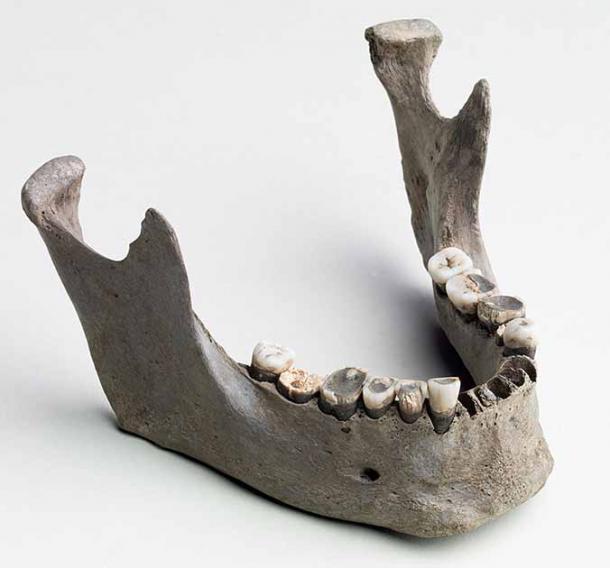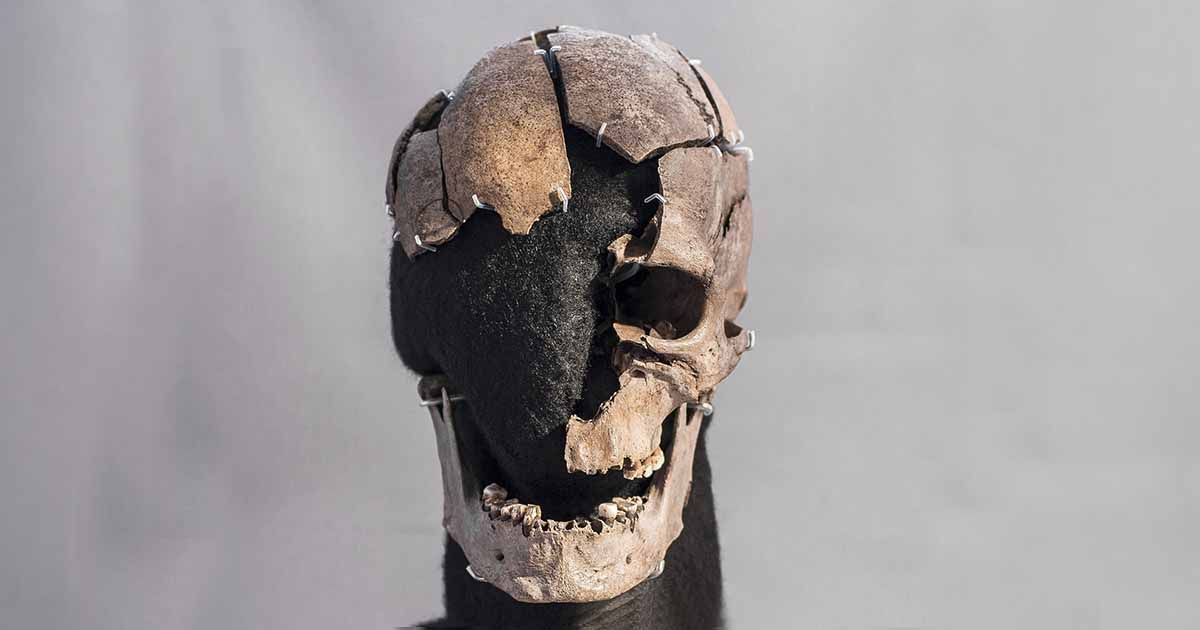Research Reveals Complex Life of the Vittrup Man’s Danish Bog Body
An international team of scientists recently completed a comprehensive analysis of the remains of a body extracted from a peat bog in Denmark. Using DNA testing, plus various types of chemical analysis of the bones and teeth of this so-called “bog body,” the researchers have uncovered some surprising and fascinating facts about the life of the 5,000-year-old Vittrup Man, a victim of ancient ritual sacrifice who was removed from his watery tomb by peat harvesters more than a century ago.
Dated to approximately 3,300 to 3,100 BC, the Vittrup Man was previously believed to have been a lifelong resident of ancient Denmark. But in a paper just published in the journal PLOS ONE, the scientists who carried out the study clarified that this assumption is incorrect. In fact, their research proves that the Vittrup Man was actually born somewhere along the northern coast of either Norway or Sweden, quite a distance away from the bog near the Danish village of Vittrup where his skeletal remains were deposited.
- The Stories Behind Seven Mind Boggling Bog Bodies
- What Killed Grauballe Man? Explaining the Puzzle of the Iron Age Bog Body
Genetic testing of the skeleton’s ancestral heritage firmly established the region of northern Scandinavia as the Vittrup Man’s true birthplace, which suggests that he was an immigrant who joined a Danish farming community after migrating southward, presumably sometime during adulthood. This means he completed a rather remarkable and unusual life journey, one that ended in premature death in a ritual designed to appease ancient deities worshipped by the Danish people of Neolithic times.

Map of southern Scandinavia showing the location of humans and areas mentioned within the study. (Fischer et al., 2024, PLOS ONE / CC BY 4.0 DEED)
Tracking the Vittrup Man’s Body Across Northern Europe and on to the Afterlife
By itself, DNA links with northern Scandinavian peoples would not be enough to prove that the Vittrup Man was born outside the lands of ancient Denmark. His parents or grandparents could have been the ones to migrate to Denmark decades earlier, making him a native despite the genetic variance with his neighbors.
But the international research team, which featured scientists from Denmark, Sweden, the United States and the United Kingdom, was able to demonstrate that the Vittrup Man had lived in northern Scandinavia for a while. Isotope testing of the bog body’s teeth and bones showed a change in diet that occurred sometime between childhood and adulthood.
The isotopes of strontium, carbon and oxygen trapped in his tooth enamel revealed that the Vittrup Man must have spent his childhood living along the coast in northern Scandinavia, among people who’d consumed a diet consistent with a fishing and hunting lifestyle. But sometime between adolescence and young adulthood, he switched from eating fish and marine mammals to consuming the meat of domesticated farm animals, including sheep and goats.
Regardless of his origins, at some point the Vittrup Man had become fully integrated into the local farming community that existed in northern Denmark in 3,300 BC, enough so that he was chosen to be a sacrificial victim when his neighbors were seeking the favors of the gods.
The researchers responsible for the new study of the Vittrup Man’s diet and genetic inheritance admit they can’t be certain as to why their subject relocated from Norway or Sweden to Denmark. They speculate that he may have been a trader who simply decided to settle down in a new place, and they also raise the possibility that he was some type of captive who didn’t migrate southward willingly (if the latter was the case, he may have been sacrificed against his will). He may also have been an adventurer who simply wanted to get out and experience the wider world, ultimately deciding to settle down and make a home for himself in a new territory with a more dependable food supply.

Analysis of the Vittrup Man’s teeth provided invaluable clues as to the complex life history of the Vittrup Man. (Arnold Mikkelsen / Fischer et al., 2024, PLOS ONE / CC-BY 4.0)
The Story of the Vittrup Man and the Bog Body Phenomenon
The Vittrup Man is comprised of a fragmented skeleton that was found preserved in a peat bog near the tiny village of Vittrup in northwestern Denmark in 1915. Previous work on the body had established that the skeleton belonged to a male between the ages of 30 and 40, who had apparently lived and died between 5,300 and 5,100 years ago. After he was ritually sacrificed his body was then thrown into the peat bog as part of the ritual, where it remained preserved for more than 5,000 years, before it was finally discovered by a group of stunned peat harvesters.
The Vittrup Man is not an unusual find. Since the 19th century hundreds of bog bodies have been retrieved from peat bogs in northern Europe, with Denmark being responsible for the lion’s share of these discoveries. The oldest recovered bog body, known as the Koelbjerg Man, died around 8,000 BC, and like the Vittrup Man was also recovered from a Danish bog.
- Exciting Find of a Neolithic Bog Body in Denmark
- The Tollund Man Spills His Guts: New Analysis of Bog Body’s Last Meal
While accidental drownings could explain some of the bodies, and some of the deceased may have died of natural causes, most of the victims were sacrificed to fertility goddesses by Celtic and Germanic peoples seeking to ensure good harvests, or good fortune all around. It is believed that most of the dead accepted their fates willingly, choosing to lay down their lives and transition to the afterworld to help their people prosper.

End of life for Vittrup Man. (Anders Fischer (contents) and Niels Bach (drawing) / CC-BY 4.0)
Because of the unique chemical properties of peat bogs, the bodies that were placed inside them often underwent a process of natural mummification. This preserved their corpses in a nearly lifelike state, which was maintained despite the passage of many centuries. In the case of the world’s most well-known bog body, the 2,300-year-old Tollund Man, his body was so perfectly preserved that Danish police were actually able to take his fingerprints.
The Vittrup Man was nowhere near this well-preserved, however. Only parts of his skeleton remained, along with a small collection of burial goods that were tossed into the bog beside him. These included a wooden club, a ceramic vessel and bovine bones, the latter of which likely related to the man’s farming activities. Notably, the man’s skull had been violently smashed in, which undoubtedly caused his death and was consistent with the notion that he was a victim of ritual sacrifice.
One interesting facet of the Vittrup Man’s genetic makeup is that his similarities link him with Scandinavians connected to the Mesolithic period culture, which in most parts of the world covers the period from about 10,000 BC to 8,000 BC.
Now that scientists know so much about the Vittrup Man’s personal history, it may help illuminate some of the mysteries that surround the transition from the Mesolithic period to the Neolithic period in northern Europe. It would seem the Mesolithic period endured a bit longer in the frozen north, enough to make the Vittrup Man a true transitional figure connecting two distinct cultures.
“To our knowledge, this is the first time that research has been able to map a north European inhabitant’s life history in such a high degree of detail and in such high distance of time,” the study authors wrote, highlighting the groundbreaking nature of their work.
Even if other bog bodies are eventually subjected to the same type of testing, the Vittrup Man’s connections to two different regions may make his life history entirely unique.
Top image: The cranial remains of Vittrup Man, who ended up in a bog after his skull had been crushed by at least eight heavy blows. Source: Stephen Freiheit / Fischer et al., 2024, PLOS ONE / CC-BY 4.0
By Nathan Falde
References
Fischer A, Sjögren K-G, Jensen TZT, Jørkov ML, Lysdahl P, Vimala T, et al. (2024) Vittrup Man–The life-history of a genetic foreigner in Neolithic Denmark. PLoS ONE 19(2): e0297032. https://doi.org/10.1371/journal.pone.0297032

















